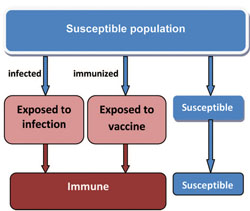1.2.4 Herd immunity
Herd immunity refers to the level of resistance against a specific communicable disease in the community as a whole. When a high proportion of a community is immune to a particular disease that spreads from person to person (e.g. measles), the infectious agents causing that disease find it difficult to infect any non-immune (susceptible) people. This could result in the infection ‘dying out’ in that community, because there are not enough infected people to act as a reservoir for the infectious agents. A high level of herd immunity benefits everyone, because it makes it more difficult for a particular infection to spread from person to person through that community.
Suggest two ways in which the level of herd immunity can increase in a community.
If a vaccine exists, immunization of a large proportion of community members is the best way to increase their herd immunity. If there is no vaccine, but a large proportion have suffered from a particular infection in the past and recovered from it, herd immunity increases because many people have naturally acquired active immunity (Figure 1.3).
Note that herd immunity is not relevant in communicable diseases where the main reservoir of infectious agents is the environment (e.g. tetanus), or in other animals (e.g. rabies). Susceptible people can still be exposed to these infectious agents, even if herd immunity is very high, because they do not usually spread from person to person.

The aim of a comprehensive immunization programme is to raise the level of herd immunity so that almost everyone in the population is immune. The immunization coverage rate is the proportion of the population that has been immunized. An immunization coverage rate of over 80% can produce effective herd immunity for some communicable diseases. However, some infectious agents, such as the measles virus, are so easily spread from infected to susceptible people that they require much higher immunization coverage rates — close to 100% — in order to produce effective herd immunity.
1.2.3 Summary of types of specific immunity
